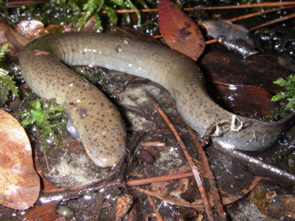
Siren lacertina
Photo by Nick DiLuzio
Description: The greater siren is an aquatic species with a stout, eel-like body. Adults are usually gray or olive, with dark spots on the head, back, and sides. The sides are lighter in color, and have many faint greenish-yellow dashes and blotches. These salamanders have external gills with 3 gill slits. They have front limbs with 4 toes. The tail is compressed with a rounded tip. Greater sirens can range from 49 to 97 cm in length. The common name "greater" comes from the fact that the other species in the genus, the lesser siren (Siren intermedia) measures less than 2 feet in total length, in contrast to the greater sirens which can exceed 3 feet in length. It can be very difficult to distinguish small greater sirens from adult lesser sirens. Counting costal grooves, external grooves along the sides of the animal between the forelimbs and the vent, which correspond roughly to the number of ribs, is a good way to differentiate between the species. Greater sirens usually have more than 36 costal grooves whereas lesser sirens have less than 35 grooves.
Habitat/Range: Sirens are most commonly found in ditches, lakes, ponds and other slow-moving fresh water. This nocturnal species spends most of the day hidden under debris or rocks, burrowed in mud or thick vegation. Young are often seen amid water-hyacinth roots. In times of drought they aestivate in mud burrows. Their skin glands secrete a moisture-sealing cocoon over their entire body except the mouth. Greater sirens occur from southern Maryland in the Coastal Plain south through peninsular Florida and west to southern Alabama.
Diet: Sirens, like amphiumas, are effective predators of many small aquatic animals. They feed primarily on aquatic invertebrates, such as crustaceans and insect larvae. They also eat amphibian eggs and larvae, small fish, and may consume some aquatic plants.
Reproduction: Little research has been done regarding reproduction in the greater siren. Eggs are usually laid sometime during the months of February and March. The larvae hatch approximately two months later, in April or May. The newly hatched larvae are about16 mm long. Males apparently fertilize eggs as the females lay them, because no spermatophores are produced. Little is known about courtship and mating. Females lay 100 – 500 eggs singly or in small groups attached to leaf litter in shallow water.

The shaded region represents the range of the greater siren in North Carolina.
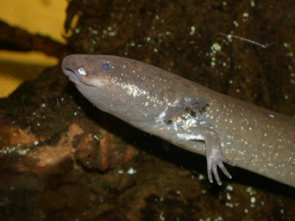
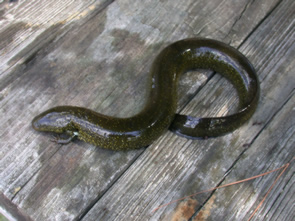
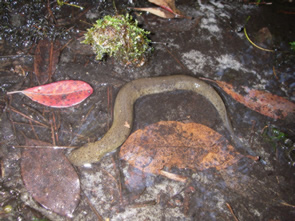
Greater sirens often have greenish-yellow dots.
Photo
by JD Willson
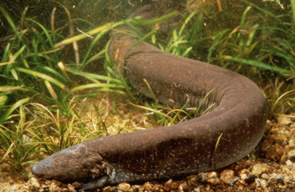
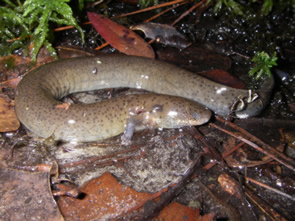
Photo by ME Dorcas
Photo by Nick DiLuzio
